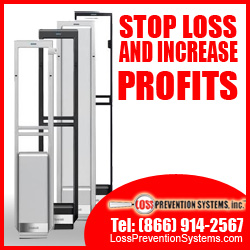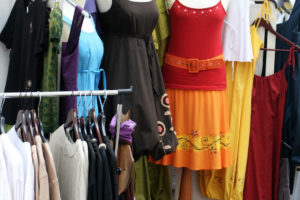 NO! not yet. Before we begin patting ourselves on the back you must remember that your Sensormatic System is only part of your shoplifting solution. Your Sensormatic System will protect your merchandise however, many shoplifters are determined and will try to steal anyway. The Sensormatic System itself is a deterrent. Its mere presence will dissuade many shoplifters.
NO! not yet. Before we begin patting ourselves on the back you must remember that your Sensormatic System is only part of your shoplifting solution. Your Sensormatic System will protect your merchandise however, many shoplifters are determined and will try to steal anyway. The Sensormatic System itself is a deterrent. Its mere presence will dissuade many shoplifters.
There are TWO PARTS to the shoplifting solution. Loss Prevention Systems, Inc. (LPSI) did not invent them, we simply perfected them both. So in your case:
✓ Sensormatic System installed by Loss Prevention Systems.
√ Staff training by Loss Prevention Systems. LPSI includes FREE anti-shoplifting training with every Sensormatic system you purchase from us, as often as you reasonably need it.

Let’s discuss the training to teach your staff how to deter shoplifters. First, we have to get our heads straight about your Sensormatic System. The system is there protecting your tagged merchandise 24/7. It is critical to have but you must realize that to fully stop shoplifters, the first line of defense must be customer service. Shoplifters hate customer service. They do not want you near them and need privacy to conceal your merchandise even if only for a moment.
We want to teach your staff to approach every customer and at a minimum greet them. Did you know that over half of all shoplifters are classified as “impulse” shoplifters? An impulse shoplifter is someone who has entered your store and will only shoplift if you give them the opportunity. Many studies over the years have shown that most impulse shoplifters will not shoplift in your store, during that visit if they are properly greeted! Wow, that means that if you or your staff greet them when they walk in the door with a verbal greeting such as “welcome to xxxx” and as important use good eye contact that it is likely that the impulse shoplifter will not steal from you during that visit! So you have put a serious dent in your shoplifting losses by just greeting customers.
Of course, greeting customers also helps us to achieve higher sales. It gives the legitimate customer a chance to ask a question and makes them feel more at home. Think about it, good customers love customer service, shoplifters hate it. Customer service everyone to death and increase your sales and reduce your shoplifting losses all with one technique.
 Now that fall is upon us it is getting darker earlier. These hours of darkness can bring unique challenges for retail owners. Have you ever considered that it is your responsibility to help keep customers and employees remain safe while they are on your property? It may make sense that you are responsible for employee safety but you are also obliged to help keep customers safe as well. This includes your parking lot and the exterior areas around the building. How do you do this? What do you have to protect against? Good questions and hopefully we can provide you with answers to those questions and suggestions to make your business safer.
Now that fall is upon us it is getting darker earlier. These hours of darkness can bring unique challenges for retail owners. Have you ever considered that it is your responsibility to help keep customers and employees remain safe while they are on your property? It may make sense that you are responsible for employee safety but you are also obliged to help keep customers safe as well. This includes your parking lot and the exterior areas around the building. How do you do this? What do you have to protect against? Good questions and hopefully we can provide you with answers to those questions and suggestions to make your business safer. For a small business owner, bringing sales to their business is not an easy feat.
For a small business owner, bringing sales to their business is not an easy feat. Maybe you have seen it before and never gave it much thought, you walked by a cash register and saw a gift card lying next to it. A customer probably just changed their mind, right? Perhaps you saw your salesfloor person wearing a heavy jacket while working but you just attributed it to them being cold all the time. You may notice cash shortages periodically but they are under $10 and some people get busy and make little mistakes, it happens. Then there is the cashier that seems to be really interested in the store and always reports suspicious people he sees. He even asks managers if there might be security camera footage that could be reviewed to see the “suspect” in case they return. There is the saleswoman who finds a lot of empty packages on the floor and reports them to the manager and where she found them so managers would know about theft taking place in the store. These each seem like harmless issues on the surface but could there be something more nefarious going on under your nose? Is something starting to seem a bit curious after all? If you are suspecting something dishonest may be going on in your store what is your next step?
Maybe you have seen it before and never gave it much thought, you walked by a cash register and saw a gift card lying next to it. A customer probably just changed their mind, right? Perhaps you saw your salesfloor person wearing a heavy jacket while working but you just attributed it to them being cold all the time. You may notice cash shortages periodically but they are under $10 and some people get busy and make little mistakes, it happens. Then there is the cashier that seems to be really interested in the store and always reports suspicious people he sees. He even asks managers if there might be security camera footage that could be reviewed to see the “suspect” in case they return. There is the saleswoman who finds a lot of empty packages on the floor and reports them to the manager and where she found them so managers would know about theft taking place in the store. These each seem like harmless issues on the surface but could there be something more nefarious going on under your nose? Is something starting to seem a bit curious after all? If you are suspecting something dishonest may be going on in your store what is your next step? In every career, there are people, places, and things that help to shape who you become in that career. A Retail Loss Prevention career is no different. My career in Loss Prevention goes back nearly 27 years. A long time ago in a department store not far away I was hired as a Loss Prevention Associate with only my military experience and a college degree in hand. I had absolutely no Loss Prevention background. There have been lessons learned along the way that shaped the way I approached Loss Prevention and the way I developed my style of working with people and managing others.
In every career, there are people, places, and things that help to shape who you become in that career. A Retail Loss Prevention career is no different. My career in Loss Prevention goes back nearly 27 years. A long time ago in a department store not far away I was hired as a Loss Prevention Associate with only my military experience and a college degree in hand. I had absolutely no Loss Prevention background. There have been lessons learned along the way that shaped the way I approached Loss Prevention and the way I developed my style of working with people and managing others. How many times have you caught yourself in a conversation with another manager or a supervisor discussing a seasonal merchandise question or an inventory preparation question and found yourself saying, “I think we did it this way” or “ It seems to me customers were buying such and such last year”? It can be frustrating, especially when the discussion may influence whether an item should be carried or if it was carried the prior year was it a flop? The same thing happens with inventory. Did we start prepping 5 days out? No? Maybe it was 3 days out. Having checklists can make these conversations fewer in number and improve productivity as well as sales performance.
How many times have you caught yourself in a conversation with another manager or a supervisor discussing a seasonal merchandise question or an inventory preparation question and found yourself saying, “I think we did it this way” or “ It seems to me customers were buying such and such last year”? It can be frustrating, especially when the discussion may influence whether an item should be carried or if it was carried the prior year was it a flop? The same thing happens with inventory. Did we start prepping 5 days out? No? Maybe it was 3 days out. Having checklists can make these conversations fewer in number and improve productivity as well as sales performance.
 Loss Prevention Managers and Associates use audits on a regular basis to keep track of merchandise that may be potentially high theft items. The items may be high dollar such as iPods, laptops, computer tablets and so on. The products being audited may simply be easy to steal and resell. Such items can include a variety of products ranging from drill bits to medicines, razor blades and even fragrances. Audits are an effective tool for Loss Prevention departments to quickly identify theft trends and to begin investigating when and how losses are taking place. For stores that cannot afford a Loss Prevention department, it falls upon store owners and managers to investigate missing merchandise. The question then becomes, how does a management team decide what items should be audited or when audits should take place?
Loss Prevention Managers and Associates use audits on a regular basis to keep track of merchandise that may be potentially high theft items. The items may be high dollar such as iPods, laptops, computer tablets and so on. The products being audited may simply be easy to steal and resell. Such items can include a variety of products ranging from drill bits to medicines, razor blades and even fragrances. Audits are an effective tool for Loss Prevention departments to quickly identify theft trends and to begin investigating when and how losses are taking place. For stores that cannot afford a Loss Prevention department, it falls upon store owners and managers to investigate missing merchandise. The question then becomes, how does a management team decide what items should be audited or when audits should take place?  Shoplifters seem to be getting bolder than ever. Much of this is greed. Many people simply want stuff and have no moral compass. Others are emboldened by lax law enforcement or Politicians that pass laws that do little to protect you. Whatever the case be, it has a negative impact on Retailers. We are expected to open our stores, compete, pay employees, pay expenses, taxes…. And make a profit. Shoplifting theft is yet another pressure on us.
Shoplifters seem to be getting bolder than ever. Much of this is greed. Many people simply want stuff and have no moral compass. Others are emboldened by lax law enforcement or Politicians that pass laws that do little to protect you. Whatever the case be, it has a negative impact on Retailers. We are expected to open our stores, compete, pay employees, pay expenses, taxes…. And make a profit. Shoplifting theft is yet another pressure on us.